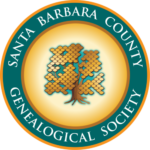Exhibit: Santa Barbara Asian American & Pacific Islander Heritage, 1870s-1970s
Henry Isao Nakada (1922-2008)
Research Scientist, Decorated Soldier and Family Elder
By Mary Hancock
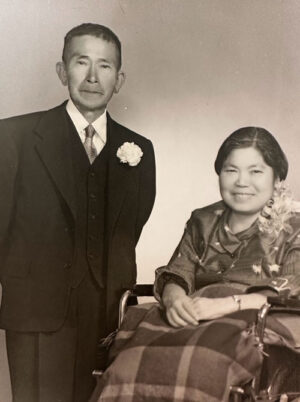
Ginzo and Kagi Nakada, ca. 1953. (Courtesy of John Okamoto)
Henry Isao Nakada (October 12, 1922 – March 13, 2008), who lived in Santa Barbara from 1962 to 1978 with his wife, Mitsu, and four sons, was a highly decorated WWII veteran who fought in Italy, France and Germany. He later advanced the understanding and treatment of rheumatoid arthritis and diabetes as a biochemist.
Family Background and Early History
Henry grew up in a family of 11 children, 9 boys and 2 girls; a twelfth child, a girl, died in infancy. His father, Ginzo, was born in 1884 or 1885 in Kin-mura village in Okinawa; he was married in 1916 to Kagi Ikehara and together they immigrated to the US that same year. They settled in Azusa, where Ginzo was self-employed as a citrus rancher.
Henry attended schools in LA County and, after graduating from Covina High School in 1939, left home with the aim of earning enough money to attend college – a goal inspired by his three older brothers, each of whom had earned a college degree. He worked as a temporary agricultural laborer in California and Oregon and, after hearing that the wages were better in Alaska, continued northward. In Alaska, he worked on the Alaska Railroad, in commercial fishing, and in construction at Elmendorf Air Force Base. After the bombing of Pearl Harbor, he was fired from his job at Elmendorf because of his Japanese heritage. He was determined to serve his country, however, and after lying about his age (he was 17 at the time), persuaded an Army recruiter to allow him to enlist and began service in April 1942.
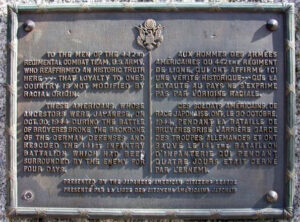
Plaque Dedicated to the 442nd Regimental Combat Team, Bruyeres, France (Courtesy Chris Komai, Proud to Serve (2012))
Military Service
Following his training, Henry was assigned to the Second Battalion of the 442nd Regimental Combat Team, known as the Nisei Unit, where he served in I Company as a scout. His brother, George, later joined him in the 442nd, in H Company. In addition, five other brothers were also deployed. With seven sons in the Army, the Nakadas gained national recognition for having the most family members in service.
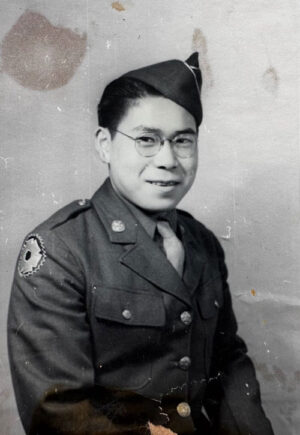
Private First Class Henry Nakada (Courtesy of John Okamoto)
Henry served in Europe for 16 months and his unit was recognized for “outstanding performance of duty in action” in France (1944) and Italy (1945) including the heroic rescue of the 141st Texas Regiment from behind enemy lines in the Vosges Mountains of France. Henry was eventually decorated with a Good Conduct Medal, an American Theater Service Medal, an Asiatic Pacific Service Medal, a Purple Heart Medal with 2 Oak Leaf Clusters, an EAME Service medal with 4 Bronze Stars and, in 2003, he received a Bronze Star based on military review of past records.
Detention
In August 1942, with three of their sons already in military service and four soon to enlist, the family was detained at the Heart Mountain Relocation Center in Wyoming. In September 1943, the Nakadas were transferred to Gila River Relocation Center in Arizona to accommodate Kagi’s worsening health. Kagi had multiple sclerosis and her condition was exacerbated by Wyoming’s harsh weather. Henry recalled that other detainees, including a nursing student, Mitsu Hasegawa, often provided medical assistance and support for Kagi. Henry was grateful to Mitsu for her help and they exchanged letters over the next few years.
The family remained at the Gila River center until January 1945, when they returned to their 10-acre farm in Azusa. They tried to start over, but it was difficult, with seven sons still deployed and most of their equipment either requisitioned or stolen. In a 1945 interview published in Yank Magazine, Ginzo explained, “It took me quite a while to build this place so that I could make a living for my family… Now I’m almost back to where I started 40 years ago. When the war is over and my sons come back I ought to be able to make things run again, but right now, with the war and so little to work with and the way people feel these days, it’s hard. But we’ll see.”
Marriage, Family and Career Paths
After his discharge, Henry visited Mitsu in Philadelphia to thank her for caring for his mother at Heart Mountain. Mitsu was then enrolled in nursing school. He planned to stay only a few days, but soon decided that “she was the one,” and after extending his stay, proposed marriage. He recalled in a later interview with the Japanese American Military History Collective: “I decided on the fourth day, that I wanted to marry her, took another 10 days to ask. We were married for 56 years.”
The couple wed in 1946 and continued their educations. Mitsu completed her training as a public health nurse and Henry studied organic chemistry at Temple University, receiving a PhD in biochemistry in 1953. They lived and worked in Philadelphia for another year and in 1954, moved to San Diego, where Henry took a research position at Scripps Clinic and Research Foundation in La Jolla. In 1961, Henry began work as a faculty member in UC Santa Barbara’s Department of Biology. Supported by major federal grants, he led research projects on the metabolic processes involved in diabetes and rheumatoid arthritis; he also directed the campus’s study abroad center in Tokyo for 2 years.
While at UCSB, Mitsu and Henry lived in the San Marcos Pass area; they raised three sons, Robert, Michael and Chris, and fostered a fourth son. Henry’s nephews, John and Rich Okamoto, who lived in Goleta with their parents Grace Nakada Okamoto and Masato Okamoto, remember the closeness of their families: “We were always in and out of each other’s houses!” Henry’s sons, Robert, Michael and Chris moved to Alaska after completing high school and, after his retirement in 1978, Henry and Mitsu followed their sons, making a new home on the Kenai Peninsula, in Homer. For Henry, this return to the far north allowed him a third career, working for a time in commercial fishing and later in sales. Mitsu continued her work as a public health nurse, traveling to remote villages throughout the state to deliver care.
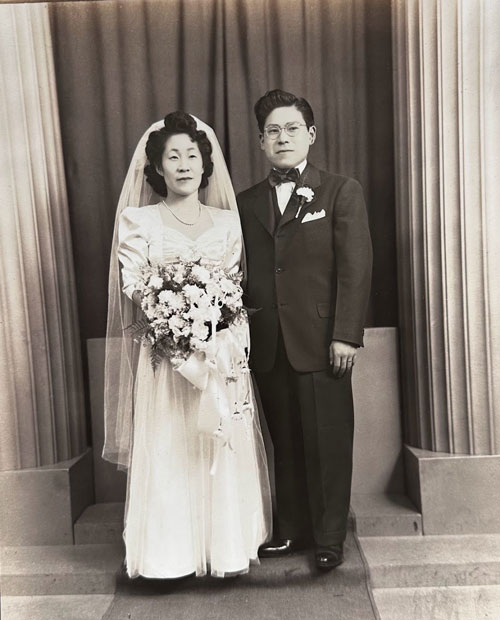
Henry and Mitsu’s Wedding, 1946 (Courtesy of John Okamoto)
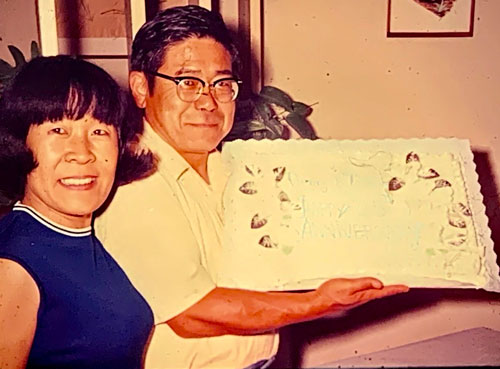
Henry and Mitsu (Courtesy of John Okamoto)
Lives of Consequence
Henry and his family were scarred by WWII and by the various forms that anti-Asian prejudice took before, during, and after the war. His experiences on the battlefield yielded scars, both bodily wounds and difficult memories. But he was undeterred by those hurdles, cultivating resilience that enabled him to make scientific contributions that impacted and enriched the lives of his immediate family and countless others.
Acknowledgements
Warm thanks to Rich and John Okamoto for sharing their stories, family histories, and photographs.
References
“Claim Five in Service Largest” Manzanar Free Press, August 5, 1944. Library of Congress Digital Collections, Japanese-American Internment Camp Newspapers, 1942-1946. https://www.loc.gov/collections/japanese-american-internment-camp-newspapers/
“Ginzo Nakada.” “Japanese American Internee Data File, 1942-1946,” “United States Japanese Americans Relocated During World War II, 1942-1946”, Accessed via FamilySearch (https://www.familysearch.org/ark:/61903/1:1:KX2D-GK4 : 13 June 2022).
Ginzo Nakada. “California, San Francisco, Immigration Office Special Inquiry Records, 1910-1941,” Accessed via FamilySearch (https://familysearch.org/ark:/61903/1:1:QLHC-T3XQ : 17 March 2018), NARA microfilm publication M1388, Registers of Persons Held for Boards of Special Inquiry at the San Francisco, California, Immigration Office, February 1910-May 1941, affiliate film #2, (Washington D.C.: National Archives and Records Administration, n.d.)
“Ginzo Nakada” “United States, War Relocation Authority centers, final accountability rosters, 1942-1946,” Accessed via FamilySearch (https://www.familysearch.org/ark:/61903/1:1:QLXR-4RNN : 9 January 2023), NARA microfilm publication M1865 (Washington D.C.: National Archives and Records Administration, 2001).
“Ginzo Nakada,” “United States, War Relocation Authority centers, final accountability rosters, 1942-1946,” Accessed via FamilySearch (https://www.familysearch.org/ark:/61903/1:1:QLXR-4X84 : 9 January 2023), NARA microfilm publication M1865 (Washington D.C.: National Archives and Records Administration, 2001).
“Henry Nakada” Biographical File, Office of Public Information Biographical Files, Box 31 (Myers to Nichols), S1-A2-C4-R5, UCSB Davidson Library Department of Special Collections, UArch 11
“Henry Nakada Obituary,” Anchorage Daily News, April 6, 2008
“Henry Nakada Oral History Interview, May 6, 2004” Japanese American Military History Collective. https://ndajams.omeka.net/collections/show/60
“Henry I Nakada” in “United States World War II Army Enlistment Records, 1938-1946,” database, Accessed via FamilySearch (https://familysearch.org/ark:/61903/1:1:K853-V1S : 5 December 2014), “Electronic Army Serial Number Merged File, ca. 1938-1946,” database, The National Archives: Access to Archival Databases (AAD) (http://aad.archives.gov : National Archives and Records Administration, 2002); NARA NAID 1263923, National Archives at College Park, Maryland.
“Henry Isao Nakada, 1945.” In “Alaska, WWII Statement of Service Records, 1948-1949”, database, Accessed via FamilySearch (https://www.familysearch.org/ark:/61903/1:1:6ZSG-X6XC : 9 March 2021)
Hosokawa, William. [1969] 2002. Nisei: The Quiet Americans (Rev. ed). University of Colorado Press.
Komai, Chris, ed. 2012. Proud to Serve: Japanese American World War II Veterans. The Rafu Shimpo: Los Angeles.
Oana, Miwako. “150 Service Flags Fly over Heart Mountain,” Heart Mountain Sentinel, Feb. 20, 1943. Library of Congress Digital Collections, Japanese-American Internment Camp Newspapers, 1942-1946 https://www.loc.gov/collections/japanese-american-internment-camp-newspapers/
Okamoto, John and Richard Okamoto. Interview with Melinda Yamane Crawford and Mary Hancock. April 20, 2023.
O’Neill, Pvt. James. “The Nisei Problem,” Yank Magazine, July 13, 1945, pp. 22-28.
United States Census for Monrovia Judicial Township, Los Angeles, California, 1940. Accessed on FamilySearch (https://www.familysearch.org/ark:/61903/1:1:K9W9-FXD : 5 January 2021), Sixteenth Census of the United States, 1940, NARA digital publication T627. Records of the Bureau of the Census, 1790-2007, RG 29. Washington, D.C.: National Archives and Records Administration, 2012, roll 237.
